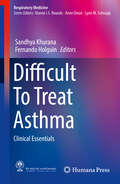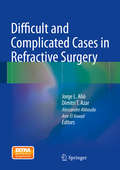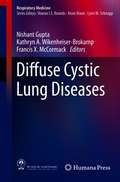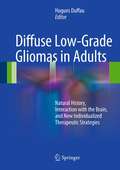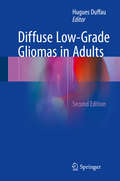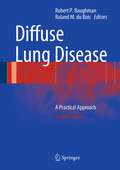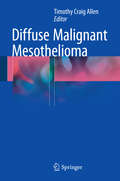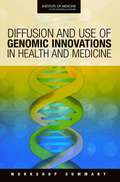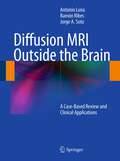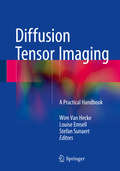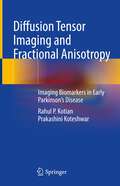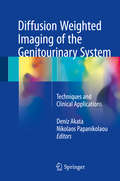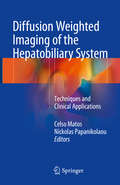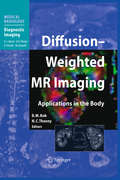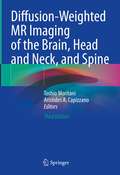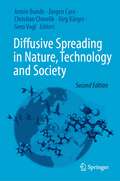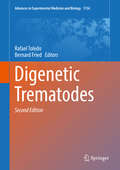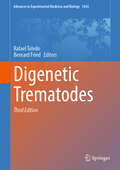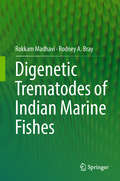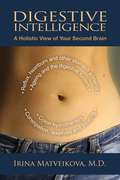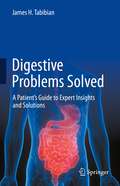- Table View
- List View
Difficult To Treat Asthma: Clinical Essentials (Respiratory Medicine)
by Sandhya Khurana Fernando HolguinThis book provides a practical, stepwise, evidence-based approach to effective management of patients with difficult to treat asthma. The impact of asthma on morbidity and healthcare utilization increases exponentially with severity. Severe refractory asthma accounts for less than 5% of all asthma. Its prevalence, however, is often overestimated as there are several other confounding factors that make asthma ‘difficult to treat’. Many novel (albeit expensive) therapies are now available and providers caring for patients with severe asthma are charged with selecting the best evidence treatment. This calls for complex and nuanced decision-making. Whether people with asthma gain and maintain control over their condition depends not only on the availability of effective drugs, but also multiple patient and healthcare provider behaviors. Therefore, now more than ever, it has become increasingly important to differentiate “difficult” from “severe refractory” asthma to allow identification of patients most likely to benefit from these therapies. This volume delves into the current understanding of mechanisms and increasingly recognized heterogeneity of this complex disease. It discusses a structured approach to identification and optimization of factors contributing to poor asthma control, including nonadherence, comorbidities and occupational/environmental triggers. The book includes ‘state of the art’ reviews on recent advances in traditional and targeted asthma therapies, as well as a glimpse into what the future may hold. Highlights include a comprehensive guide to management of severe asthma in children and pregnancy, as well as practical considerations to management of asthma based on different clinical phenotypes. Each chapter is authored by leading experts in the field who share their own clinical approach. This is an ideal guide for clinical pulmonologists and allergist/immunologists, as well as primary care providers, physician extenders in specialty practice, physicians in pulmonary/allergy training, and even industry partners.
Difficult and Complicated Cases in Refractive Surgery
by Jorge L. Alió Dimitri T. Azar Alessandro Abbouda Amr El AswadThis richly illustrated book is intended as a gold standard for the refractive surgeon. It complements the authors' successful previous book, Management of Complications in Refractive Surgery, by providing detailed practical information on the management of specific cases. Worldwide leaders in the field document a wide range of challenging cases drawn from their own clinical practice. These cases relate to the planning of refractive laser treatment; intra operative complications when using LASIK (Microkeratome and Femtosecond) and various surface treatments, including PRK, PTK and EpiLASIK; early and late postoperative complications with these treatments and a range of other complications that may arise during or after refractive surgery. This book will be an indispensable aid for the refractive surgeon and will assist in decision making when the surgeon is confronted by a difficult case.
Diffuse Cystic Lung Diseases: A Comprehensive Guide (Respiratory Medicine)
by Francis X. McCormack Nishant Gupta Kathryn A. Wikenheiser-BrokampThis book is a comprehensive reference on diffuse cystic lung diseases (DCLDs). DCLDs are a group of pathophysiologically heterogenous processes that are characterized by the presence of multiple spherical or irregularly shaped, thin-walled, air-filled spaces within the pulmonary parenchyma. In recent years, tremendous advancements have been made in these diseases leading to improved understanding of the underlying pathophysiology, and improved outcomes with targeted therapies. The authors, who are leading experts in the field, delineate DCLDs as a separate category distinct from other interstitial lung diseases, and have created this textbook specifically dedicated to this disease group. This book begins with a chapter introducing the definition and classification of DCLDs. Subsequent chapters address the pathogenic mechanisms underlying pulmonary cyst formation and provide a detailed overview of the radiological and pathological features of DCLDs. The common as well as uncommon causes of DCLDs are comprehensively reviewed in individual chapters, as are the varied clinical presentations and extrapulmonary manifestations, and approaches to management and treatment. The book culminates in a final chapter that presents a practical algorithmic approach to diagnosis that progresses from least invasive to most invasive approaches. This textbook provides a one-stop, comprehensive and integrated, clinical, radiologic, and pathologic overview of DCLDs that will be as useful to the practicing clinician as it is to the clinical investigator.
Diffuse Low-Grade Gliomas in Adults
by Hugues DuffauThis book presents the latest research pertaining to the diagnosis, therapy and management of diffuse low-grade gliomas (DLGG) in adults, with a particular focus on the path towards individualised therapy for this kind of tumour. Recent research on the natural history of DLGGs and their interaction with the brain has led to new diagnostic and therapeutic strategies which increase survival and quality of life of the patient, and these methods are described in this book.
Diffuse Low-Grade Gliomas in Adults
by Hugues DuffauThis book presents the latest research pertaining to the diagnosis, therapy and management of diffuse low-grade gliomas (DLGG) in adults, with a particular focus on the path towards individualised therapy for this kind of tumour. Recent research on the natural history of DLGGs and their interaction with the brain has led to new diagnostic and therapeutic strategies which increase survival and quality of life of the patient, and these methods are described in this book.
Diffuse Lung Disease
by Robert P. Baughman Roland M. BoisInterstitial lung diseases comprise a significant part of any respiratory medicine practice. This timely second edition of Diffuse Lung Disease is a practical clinically-oriented resource, covering all the major advances in diagnostic techniques and therapies. Authored by world authorities in the field, this book provides clear and specific recommendations for the management of all forms of interstitial lung diseases. This book is divided into two sections. The first section addresses the general aspects of diagnosis and management, including clinical approach, radiographic approach, physiological changes, and classification. The second section details each individual form of interstitial lung disease. Organized in an easy to follow format, each disease specific chapter includes tables outlining diagnostic approach, differential diagnosis, disease monitoring, and treatment. Illustrative cases, replete with high quality HRCT images, bring an added dimension to this outstanding book.
Diffuse Malignant Mesothelioma
by Timothy Craig AllenThis volume is the most up-to-date text available on diffuse malignant mesothelioma and includes all the newest imaging modalities, immunohistochemical features, and ever-expanding information on the molecular characteristics of the cancer. In-depth chapters contain fully referenced text as well as detailed tables and images. While the primary audiences for this book are pathologists and pathology residents, the broad examination of diffuse malignant mesothelioma, including its epidemiology, makes this book valuable to radiologists, surgeons, oncologists, and other clinical physicians and their residents as well. Written by experts in the field, Diffuse Malignant Mesothelioma is a concise yet comprehensive resource for clinicians involved in the management of one of the most widely recognized and feared cancers in the world.
Diffusion And Use Of Genomic Innovations In Health And Medicine: Workshop Summary
by Institute of Medicine of the National AcademiesUntil fairly recently, genetic information was used primarily in the diagnosis of relatively rare genetic diseases, such as cystic fibrosis and Huntington’s Disease, but a transformation in the use of genetic and genomic information is underway. While many predictions have been made that genomics will transform medicine, to date few of these promising discoveries have resulted in actual applications in medicine and health. The Institute of Medicine’s Roundtable on Translating Genomic-Based Research for Health, established in 2007, held its first workshop to address the following questions: 1. Are there different pathways by which new scientific findings move from the research setting into health care? 2. If so, what are the implications of those different pathways for genomics? 3. What can we learn from the translation of other new technologies as we seek to understand the translation of genome science into health care? Information obtained from the workshop was then used to further discussion and exploration of the answers to these questions. This book summarizes speaker presentations and discussions. Any conclusions reported should not be construed as reflecting a group consensus; rather they are the statements and opinions of presenters and participants.
Diffusion MRI Outside the Brain
by Ramón Ribes Antonio Luna Jorge A. SotoRecent advances in MR technology permit the application of diffusion MRI outside of the brain. In this book, the authors present cases drawn from daily clinical practice to illustrate the role of diffusion sequences, along with other morphological and functional MRI information, in the work-up of a variety of frequently encountered oncological and non-oncological diseases. Breast, musculoskeletal, whole-body, and other applications are covered in detail, with careful explanation of the pros and cons of diffusion MRI in each circumstance. Quantification and post-processing are discussed, and advice is provided on how to acquire state of the art images, and avoid artifacts, when using 1.5- and 3-T magnets. Applications likely to emerge in the near future, such as for screening, are also reviewed. The practical approach adopted by the authors, combined with the wealth of high-quality illustrations, ensure that this book will be of great value to practitioners.
Diffusion Tensor Imaging
by Wim Van Hecke Louise Emsell Stefan SunaertThis book provides an overview of the practical aspects of diffusion tensor imaging (DTI), from understanding the basis of the technique through selection of the right protocols, trouble-shooting data quality, and analyzing DTI data optimally. DTI is a non-invasive magnetic resonance imaging (MRI) technique for visualizing and quantifying tissue microstructure based on diffusion. The book discusses the theoretical background underlying DTI and advanced techniques based on higher-order models and multi-shell diffusion imaging. It covers the practical implementation of DTI; derivation of information from DTI data; and a range of clinical applications, including neurosurgical planning and the assessment of brain tumors. Its practical utility is enhanced by decision schemes and a fully annotated DTI brain atlas, including color fractional anisotropy maps and 3D tractography reconstructions of major white matter fiber bundles. Featuring contributions from leading specialists in the field of DTI, Diffusion Tensor Imaging: A Practical Handbook is a valuable resource for radiologists, neuroradiologists, MRI technicians and clinicians.
Diffusion Tensor Imaging and Fractional Anisotropy: Imaging Biomarkers in Early Parkinson’s Disease
by Rahul P. Kotian Prakashini KoteshwarThe book covers all aspects of one of the most advanced magnetic resonance imaging techniques, namely Diffusion Tensor Imaging (DTI) and Fractional Anisotropy (FA) values in early Parkinson’s disease (PD) patients. It provides step-by-step descriptions of DTI and its use in the early diagnosis of Parkinson’s disease by using FA values at several grey and white matter regions of the brain with helpful MRI DTI images. It includes clear flow charts with MRI DTI imaging protocol for Parkinson’s disease to aid in early diagnosis and treatment. The book covers essential information on anatomy and pathology in Parkinson’s disease and includes dedicated chapters on diffusion tensor imaging and FA in Parkinson’s disease. Additionally, it covers the role of magnetic resonance imaging in Parkinson’s disease with routine findings for Parkinson’s disease in MRI, followed by advanced imaging biomarkers and predictors in Parkinson’s disease. The book will assist the practitioners in the early detection of Parkinson’s disease using specific imaging biomarkers with the help of FA values, which will help in the early treatment of PD patients and thus extend and improve their quality of life. It will also be relevant for MD radiology, M.Sc. medical imaging technology students/trainees and Ph.D. medical imaging graduates as well as B.Sc MIT students.
Diffusion Weighted Imaging of the Gastrointestinal Tract: Techniques And Clinical Applications
by Sofia Gourtsoyianni Nikolaos PapanikolaouThis book explains how diffusion weighted imaging has been incorporated in routine MRI examinations of the abdomen and pelvis: though its clinical role is still evolving, it is already considered an important tool for the assessment of rectal cancer treatment response, as was confirmed in recent ESGAR consensus statements. The standardization and clinical validation of quantitative DWI related biomarkers are still in progress, although certain efforts have been undertaken to establish imaging guidelines for different clinical indications/body parts. The book reviews the technical aspects and clinical applications of DWI in imaging of the GI tract, and provides specific technical details (imaging protocols, artefacts, optimization techniques) for each GI tract division. This volume is mainly intended for radiologists who are interested in abdominal radiology, as well as radiology residents. Given that magnetic resonance physics is complex and can be cumbersome to learn, the authors have made it as simple and practical as possible.
Diffusion Weighted Imaging of the Genitourinary System: Techniques And Clinical Applications
by Deniz Akata Nikolaos PapanikolaouThis book discusses diffusion weighted imaging (DWI) and its evolving clinical role. DWI has frequently been used in the abdomen and pelvis but is now increasingly being used in other clinical applications, especially for the diagnostic workup of oncologic patients. Standardization and clinical validation of quantitative DWI related biomarkers is still ongoing, although efforts have been undertaken, especially in the prostate, to provide standardized imaging guidelines for different clinical indications. The technical aspects and clinical applications of DWI presented focus on the respective anatomical region and its pathologies. The book is unique in providing tables of technical details (imaging protocols, artifacts, optimization techniques) for each chapter, making this complex area as simple and practical as possible.The book is intended for radiologists interested in urogenital radiology and also for radiology residents.
Diffusion Weighted Imaging of the Hepatobiliary System: Techniques and Clinical Applications
by Celso Matos Nickolas PapanikolaouThis book presents the core principles and technical aspects of Diffusion Weighted Imaging (DWI), as well as pearls and pitfalls concerning the imaging technique’s application to the hepatobiliary system. All technical aspects and clinical applications discussed focus on the related anatomical region and its pathologies.Given that magnetic resonance physics is complex and can be cumbersome to learn, the volume editors and authors have made it as simple and practical as possible. Accordingly, tables related to technical details (imaging protocols, artefacts, and optimization techniques) are provided for each chapter.Though DWI is frequently used in the abdomen and pelvis, its clinical role is still evolving, especially for the diagnostic workup of oncologic patients. Although certain efforts have been undertaken to standardize and provide imaging guidelines for different clinical indications, the standardisation and clinical validation of quantitative DWI-related biomarkers are still works in progress. Addressing this gap, the book offers a useful tool for radiologists with a particular interest in abdominal radiology, as well as for radiology residents.
Diffusion-Weighted MR Imaging
by Harriet C. Thoeny Dow-Mu KohThe clinical applications of diffusion-weighted MR imaging (DW-MRI) in the body are rapidly evolving. This volume highlights state-of-the-art techniques for performing DW-MRI measurement in the body and addresses important practical issues. Key points are highlighted that will help radiologists and technologists to acquire high-quality images for disease assessment and to adapt the technique to their own clinical practice or research. The major clinical applications of DW-MRI in the body, both oncological and non-oncological, are extensively illustrated, providing readers with a broad insight into the growing uses of the technique. The final section addresses future developments, considering the potential importance of the technique in relation to drug development and the ways in which DW-MRI might be combined with other functional imaging techniques to further improve disease assessment.
Diffusion-Weighted MR Imaging of the Brain, Head and Neck, and Spine
by Toshio Moritani Aristides A. CapizzanoThis richly illustrated book, now in an updated and extended third edition, systematically covers the use of diffusion-weighted (DW) MR imaging in all major areas of neuroradiology, including imaging of the head and neck and the spine as well as the brain. The authors guide the reader from the basic principles of DW imaging through to the use of cutting-edge diffusion sequences such as diffusion tensor (DTI) and kurtosis (DKI), fiber tractography, high b value, intravoxel incoherent motion (IVIM), neurite orientation dispersion and density imaging (NODDI), and oscillating gradient spin echo (OGSE). Pathology, pathophysiology, and patient management and treatment are all thoroughly discussed. Since the early descriptions by LeBihan and colleagues of the ability to image and measure the micromovement of water molecules in the brain, diffusion imaging and its derivatives have contributed ever more significantly to the evaluation of multiple disease processes. In comprehensively describing the state of the art in the field, this book will be of high value not only for those who deal routinely with neuro-MR imaging but also for readers who wish to establish a sound basis for understanding diffusion images in the hope of extending these principles into more exotic areas of neuroimaging.
Diffusive Spreading in Nature, Technology and Society
by Armin Bunde Jörg Kärger Jürgen Caro Gero Vogl Christian ChmelikWhat do the movements of molecules and the migration of humans have in common? How does the functionality of our brain tissue resemble the flow of traffic in New York City? How can understanding the spread of ideas, rumors, and languages help us tackle the spread a pandemic? This book provides an illuminating look into these seemingly disparate topics by exploring and expertly communicating the fundamental laws that govern the spreading and diffusion of objects. A collection of leading scientists in disciplines as diverse as epidemiology, linguistics, mathematics, and physics discuss various spreading phenomena relevant to their own fields, revealing astonishing similarities and correlations between the objects of study—be they people, particles, or pandemics.This updated and expanded second edition of an award-winning book introduces timely coverage of a subject with the greatest societal impact in recent memory—the global fight against COVID-19. Winner of the 2019 Literature Prize of the German Chemical Industry Fund, this book targets an interdisciplinary readership, featuring an introductory chapter that sets the stage for the topics discussed throughout. Each chapter provides ample opportunity to whet the appetite of those readers seeking a more in-depth treatment, making the book also useful as supplementary reading in appropriate courses dealing with complex systems, mass transfer, and network theory.
Digenetic Trematodes (Advances in Experimental Medicine and Biology #1154)
by Rafael Toledo Bernard FriedDigenetic trematodes constitute a major helminth group that parasitize human and animals and are a major cause of morbidity and mortality. The diseases caused by trematodes have been neglected for years, especially as compared with other parasitic diseases. However, the geographical limits and the populations at risk are currently expanding and changing in relation to factors such as growing international markets, improved transportation systems, and demographic changes. This has led to a growing international interest to the trematode infections, although factors such as the difficulties entailed in the diagnosis, the complexity of human and agricultural practices, the lack of assessments of the economic costs, or the limited number of effective drugs are preventing the development of control measures of these diseases in humans and livestock. In-depth studies are needed to clarify the current epidemiology of these helminth infections and to identify new and specific targets for both effective diagnosis and treatments. The main goal of the second edition of this book is to present the major trematodes and their corresponding diseases in the framework of modern parasitology, considering matters such as the application of novel techniques and analysis of data in the context of host-parasite interactions and to show applications of new techniques and concepts for the studies on digenetic trematodes. This is an ideal book for parasitologists, microbiologists, zoologists, immunologists, professional of public health workers, clinicians and graduate and post-graduate students.
Digenetic Trematodes (Advances in Experimental Medicine and Biology #1454)
by Rafael Toledo Bernard FriedAlthough digenetic trematodes have been largely neglected, they constitute a major group of helminths that parasitize human and animals causing significant morbidity and mortality. This is of special importance today, since the geographical limits and the populations at risk, traditionally limited to developing or low-income countries, are currently expanding and changing in relation to factors such as growing international markets, improved transportation systems, and demographic changes. This has led to a growing international interest in trematode infections, although factors such as the difficulties entailed in the diagnosis, the complexity of human and agricultural practices, the lack of assessments of economic costs, or the limited number of effective drugs are preventing the development of control measures of these diseases in humans and livestock. In-depth studies are needed to clarify the current epidemiology of these helminth infections and to identify new and specific targets for both effective diagnosis and treatments. The main goal of the third edition of this book is to present the major trematodes and their corresponding diseases in the framework of modern parasitology, considering matters such as the application of novel techniques and analysis of data in the context of host-parasite interactions and also with the resident microbiota, showing the application of modern techniques and concepts to the studies on digenetic trematodes. This is an ideal book for parasitologists, microbiologists, zoologists, immunologists, public health professionals, clinicians and graduate and post-graduate students.
Digenetic Trematodes of Indian Marine Fishes
by Rokkam Madhavi Rodney A. BrayThis book is the first to explore in detail the systematics and taxonomy of the digenean fauna of fish in Indian marine waters. It includes morphological descriptions of 648 species in 190 genera and 30 families. The figures from the original publications are enhanced and made more attractive. Each description is accompanied by information on hosts and distribution. Digenetic trematodes, usually known as Digeneans, are the most diverse group of metazoan parasites of marine fishes. They are parasitic flatworms (Phylum Platyhelminthes) with a complex life-cycle and as adults inhabit mainly the alimentary system and associated organs, but also occur in the blood, under the scales, in the body cavity and in the gall and urinary bladders. Keys to families, genera and species are provided, except for a few large and controversial genera, where morphological characters are insufficient for identification. Although there is extensive literature on Digeneans, it is scattered and largely in obscure local journals. Bringing together most of the primary literature on the subject, this book provides a primer for further study and a starting point for the use of modern molecular methods for the fauna of this region. Unique in its scope, it is a valuable resource for students, professional parasitologists and ecologists as well as fishery and wildlife biologists.
Digestive Intelligence
by Irina MatveikovaDigestive Intelligence tells the fascinating story of how our digestive systems are the centre of our bodies' second brain and how we think and live our emotions via our stomachs.Not impossible when you consider there is something equivalent to the size of a village football pitch hiding inside our bellies - that's the incredible magnitude of our digestive systems. They contain an extensive network of nerve cells, called neurons, which carry information to the brain and thus have a profound effect upon our intellectual, emotional and immune processes.Dr Matveikova answers the obvious questions: "How?" and "Why can this be so?" by explaining, in straight forward layman's language, that the digestive system contains more than one million neurones, identical to those in the brain and is responsible for producing 90% of the body's hormone, serotonin, the all-important hormone which makes us feel happy and full of wellbeing. It follows, that if our stomachs are "out of sorts" we can feel irritable, in a bad mood, lacking in energy and those feelings will block our intellectual productivity, tend to disorientate us and completely change our thought patterns and physical processes.
Digestive Problems (The Everything Healthy Kids)
by Adams MediaFor parents, few experiences provoke more anxiety than the thought of a sick child. The Everything® Healthy Living Series is here to help. These concise, thoughtful guides offer the expert advice and the latest medical information you need to understand your child’s ailments and provide the best possible care. Childhood illnesses are inevitable; the way you approach treatment is not.Here you’ll find overviews of the most prevalent digestive problems from the least serious to issues of concern, advice for comforting your child, and when it might be time to see your child’s pediatrician.
Digestive Problems Solved: A Patient's Guide to Expert Insights and Solutions
by James H. TabibianMore than one billion individuals worldwide experience digestive or gastrointestinal (GI) problems, including acid reflux, bloating, constipation, diarrhea, and many others. This book was written with these individuals in mind and to help guide them. In this comprehensive yet high-yield and patient-friendly book, trusted medical expert Dr. James H. Tabibian shares his professional insights and personal experiences to empower patients to gain better understanding of and control over their digestive health. This book addresses questions that commonly arise among those with GI problems, such as “What condition do I really have?”, “Should I be worried?”, “At what point do I need to see a specialist?”, “What should I tell the doctor?”, “Is the doctor ordering the right tests for me?”, “What treatment options are there and which ones work best for me?”, “Am I seeing the right subspecialist for my problem?”, and more. It presents up-to-date scientific knowledge and tenets that are relevant across the spectrum of common GI problems, providing a summary of key concepts, underlying causes of digestive problems, how to best embark on a medical evaluation, and the vast array of pharmacological and non-pharmacological therapeutic options. Drawing upon both Western and Eastern methodologies and a combination of integrative and functional medicine, this book provides important practical information to help navigate life with GI problems, the complexities of modern healthcare, and the quest for digestive wellness, debunking misconceptions along the way.
Digestive Wellness: Strengthen The Immune System And Prevent Disease Through Healthy Digestion
by Elizabeth LipskiThe definitive guide to healthy digestion! Digestive Wellness explains how your digestive system works and what to do when it doesn't. You'll find practical solutions to all the common gastrointestinal disorders (and many other conditions) and expert guidance on the newest advances in testing and diagnosis, nutrition, and natural therapies. Plus, you'll learn how faulty digestion can affect the human body systemically, from migraines and skin issues to fibromyalgia and chronic fatigue syndrome.
Digging Up the Dead: A History of Notable American Reburials
by Michael G. KammenA funeral closes a life story, and a grave in a cemetery marks its end forever. But what happens when those left behind don't agree about the meaning of that story? Or when that disagreement extends all the way to arguments about the final resting place itself? In a surprising number of cases over the years, that's when people have chosen to grab shovels and start digging. With Digging Up the Dead, Pulitzer Prize-winning historian Michael Kammen reveals a treasure trove of fascinating, surprising, and sometimes gruesome stories of exhumation and reburial from throughout American history. Taking us to the contested grave sites of such figures as Sitting Bull, John Paul Jones, Frank Lloyd Wright, Daniel Boone, Jefferson Davis, and even Abraham Lincoln, Kammen explores how complicated interactions of regional pride, shifting reputations, and evolving burial practices led to public, often emotional battles over the final resting places of famous figures. Grave-robbing, skull-fondling, cases of mistaken identity, and the financial lures of cemetery tourism all come into play as Kammen delves deeply into this little-known- yet surprisingly persistent- aspect of American history. Simultaneously insightful and interesting, masterly and macabre, Digging Up the Dead reminds us that the stories of American history don't always end when the key players pass on. Rather, the battle- over reputations, interpretations, and, last but far from least, possession of the remains themselves- is often just beginning.
